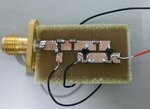myjoe1026
Junior Member level 3
Dear all,
I design a rectifier for 2.45 GHz in ADS with TXline and imported HSMS diode SPICE model.

With the LC matching, the simulation S11 is good.

When I fabricated the circuit, the result is not the same as simulation.
In fact, its efficiency is extremely low and the output DC volatge is 200mV(the simulation is 0.8V with RF to DC convertion efficiency 30%)

I wonder where is the problem? TXline is 3mm for 50ohms.
Is that too wide for SMD capacitor and or diode IC?
Thanks for your reply.
I design a rectifier for 2.45 GHz in ADS with TXline and imported HSMS diode SPICE model.
With the LC matching, the simulation S11 is good.

When I fabricated the circuit, the result is not the same as simulation.
In fact, its efficiency is extremely low and the output DC volatge is 200mV(the simulation is 0.8V with RF to DC convertion efficiency 30%)

I wonder where is the problem? TXline is 3mm for 50ohms.
Is that too wide for SMD capacitor and or diode IC?
Thanks for your reply.